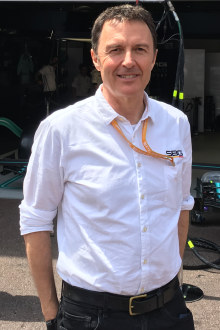“You can’t ever predict exactly what will happen in a race.”
Catapult, which began life as a partnership between the Australian Institute of Sport and the Cooperative Research Centres to maximise the performance of Australian athletes ahead of the Sydney Olympics, is now working on taking the RaceWatch platform and using it to better integrate live video feeds and real-time modelling and predictions into its own sports software, Catapult CEO Will Lopes said.
At the end of the day, there isn’t a lot of room for artistic flair in race strategy. You either get it right or wrong.
— Andrew Shovlin, Mercedes’ Director of Trackside Engineering
“Teams are using big data to better understand how their athletes are doing, how are they preventing injuries, how are they doing from a recovery perspective, how they can be at peak performance during a game, and they’re using that data and combining it with videos to make decisions around the tactics they’re going to use, the training plans they’re going to use.
“They’re really starting to think about how does data impact those decisions in real time,” Mr Lopes said.
Formula 1 has been doing all that for years, and is far ahead of the rest of the sporting industry, he said.
The team doing it the longest in Formula 1 is Mercedes, the eight-times-on-the-trot world constructors champion whose chief race strategist, James Vowles, actually helped develop the software that became RaceWatch, Mr Griffith said.

Gareth Griffith, chief technology officer, co-developed RaceWatch with Mercedes
“The fact that everybody is now using the same software to make decisions doesn’t mean everybody is converging to the same solution. It just means that fewer people are making mistakes, said Andrew Shovlin, Mercedes’ director of Trackside Engineering, who has also worked on RaceWatch since the beginning.
“Ultimately, what it comes down to is how fast your car is, how well you qualify, how well you look after the tyres, and whether you’re stopping on the right lap and putting the right tyres on.
“At the end of the day, there isn’t a lot of room for artistic flair in race strategy. You either get it right or wrong, and the more teams that are getting it broadly right, the more you’ve got to get it right yourself,” he said.
“It’s not like we’re looking at the (RaceWatch) screens and just expect them to tell us exactly how the race is going to pan out. You’re constantly looking at the screen trying to understand, what if we stop in three laps time? What if we stop right now? What if we do an extra stop?
“It’s not like we ever look at it and just say This is our crystal ball to the future. For us, RaceWatch is just a massive bag of tools, and the skill of the strategy department is still very much in the individuals who are in it,” Mr Shovlin said.


